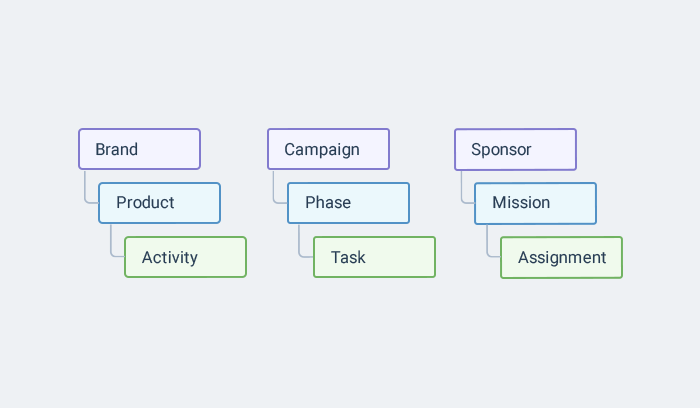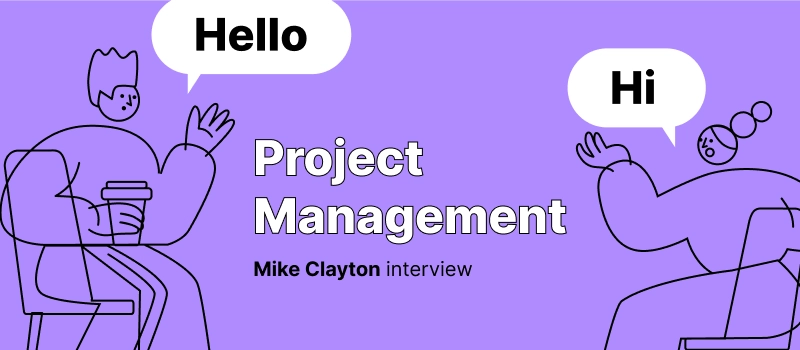
Each company has its own unique structure, and time tracking should be seamlessly built into existing business processes. An efficient time tracking tool is flexible and can be easily customized to a specific environment.
Many companies use standard customer-based and project-oriented approaches in their work. That’s why actiTIME’s default configuration has a three-level structure: customer – project – task. However, that doesn’t work for any organization, and in this case, you can adapt the worksspace for your needs. In this post, we’ll take a look at several custom use cases of organizing work structures for different types of businesses.
Phase-Centered Structure
Complex workflows that include various stages, steps or phases can be intuitively organized in process steps. This approach is popular in software development, where methodologies are used that imply strict phasing. For example, software companies that use Agile and Scrum methodology in their work can structure their workflow as follows:
Project ![]() Phase/ Sprint/ Release
Phase/ Sprint/ Release ![]() Task
Task
This structure allows to compare projects, review time they take up, and analyze their profitability. The breakdown by sprints or releases helps understand what steps are most time-consuming and where workflow can be improved to take up less time and provide faster and better results.
Product-Based Structure
This way of structuring work is a convenient option for manufacturing companies. Product is the central element of their workflow, so all work assignments are related to it. Often, a grouping of products by categories or brands is reasonable, so the most common structure for manufacturing companies is:
Product line/ Brand ![]() Product
Product ![]() Activity
Activity
If a company is not dealing with multiple brands or product lines, it can use the second level for additional data categorization by process step (design, manufacturing, QA, etc.):
Product ![]() Phase
Phase ![]() Task
Task
Customer-Based Structure
Service companies, consulting firms, law offices and other businesses that work with many specific customers find it useful to create customer-centered work structures. For example, a law firm can use the following structure:
Client ![]() Case
Case ![]() Task
Task
Architect bureaus often follow the same principle of categorization, but use different naming. For them, a common way to hierarchize work is as follows:
Customer ![]() Job/ Object
Job/ Object ![]() Task
Task
Object- or Process-Oriented Structure
In many companies, work structure is based on the object they are working with, or processes they run. For example, work in a repair shop is centered around machines they accept for repair or maintenance, or a shipping company structures its work around vessels. So, similar structures can work for them:
Vessel ![]() Job
Job ![]() Task, or
Task, or
Machine ![]() Job
Job ![]() Task
Task
Advertising agencies that run campaigns can also use similar structures and use the middle level to divide work on specific ad campaigns into phases:
Campaign ![]() Phase
Phase ![]() Task
Task
Structure-Based on Work Categories or Areas
In many companies, especially in merchandising field, work is structured by activity categories (purchase, sales, etc.), or by areas and regions where their offices or branches are located. In this case, they create a work structure according to their work categorization:
Business line/ Category of activities ![]() Product
Product ![]() Task, or
Task, or
Area ![]() Product
Product ![]() Task
Task
If their work is defined by interaction with regional clients, they can include them into their work structure:
Region ![]() Client
Client ![]() Work assignment
Work assignment
Analyzing and comparing the results by region is key for expanding business in different areas. That’s why many merchandising companies find this categorization reasonable and appropriate for their purposes. The ability to review monthly, quarterly or yearly results by activity categories helps companies analyze the profitability of specific business lines and optimize their proportions.
Structure-Based on Funding Sources
This type of structure is typical for nonprofit organizations that use it to add clarity and transparency to their accountability process. They often find it reasonable to use grants, foundations and other funding sources as the upper level in their work structure, as it defines work they spend funds and time on. An example of a nonprofit’s work structure can be as follows:
Donor/ Sponsor ![]() Mission
Mission ![]() Work assignment
Work assignment
This way of structuring work ensures a clear and easy review of what work has been performed with each donor’s funds and simplifies interaction with donating organizations and tax authorities. It also helps understand and measure the success of specific missions.
Workforce Structuring Options in actiTIME
There’s one more aspect of structuring data in your time management tool. Even in a small company, there are teams that work on different products or different parts of projects, so omitting this breakdown when creating a workspace structure is hardly an option.
In actiTIME, two user groups are available: Departments, which allow categorizing employees by professional groups or teams working on specific projects, and Time Zone Groups that work for grouping by locations or regional branches.
The ability to associate users with these groups allows managers to review the work of different teams or offices, analyze their results, and manage workloads and absences. Managers, accountants and business owners can run reports by specific departments or time zone groups to compare their performance, run payroll, plan future work, and much more.
Summary
A thoroughly designed work structure in your time management tool is essential for a clear and hassle-free time-tracking process. However, this is not the only benefit. The more structured your data is, the better opportunities you have for analyzing it and using the results in your work.
When planning the structure, think of what categorization would be clear and transparent for your employees what categories you’ll need to review, analyze and compare, and what data you’ll need to pull out of the time management tool. Consider different options, give them a try, collect feedback, and create a structure that will work best for your business and your team.
















































